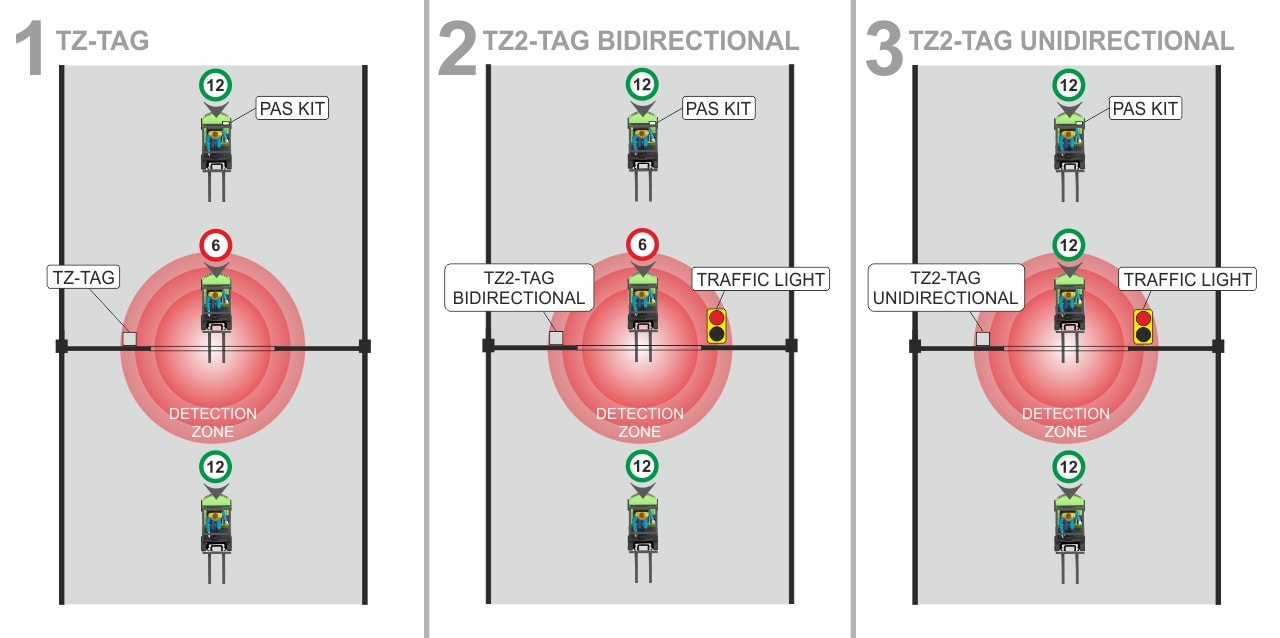
At Claitec, we develop all our solutions with real problems in mind, always seeking to improve the workflow in all types of industries, creating safer workspaces and preventing occupational accidents. Many of our clients ask us – before implementing our tools in their work environments – what are the differences between some of our solutions and what are their characteristics and qualities.
That’s why in this post we’d like to clarify the differences between the TZ-Tag, the TZ2-Tag Bidirectional and the TZ2-Tag unidirectional devices, describing the purpose of each of them.
We are looking at very similar devices that are intended for different purposes. What they have in common, though, is that all of them always achieve great results. In order to understand the practicality of each of these solutions, let us give you an example:
Imagine we want to increase safety levels in an area of the warehouse where there’s a door through which forklifts circulate.
So, let’s have look at our FIRST OPTION.
In this case, we’ll be using the TZ-Tag plus we would have installed the PAS kit on the trucks. The TZ-Tag does not have a relay, and it can only detect the AC-50 and activate the AC-50 activator relay, so this would slow down the forklift.
We could, however, install a TZ-Tag near the door where we want to enhance a safety perimeter, so when the forklift equipped with the AC-50 activator in the PAS kit enters through the TZ-Tag detection zone, it automatically reduces its speed and it stays that way for as long as it remains within the tag’s safety perimeter. Then, once the TZ-Tag stops detecting it, the forklift will return to its initial speed.
SECOND, let’s look at the possibility of combining the TZ2-Tag Bidirectional plus the PAS kit and a traffic light. This tag allows us to detect and activate the AC-50 Activator relay, which would help us reduce the speed of the forklift. In addition, it has a relay that activates the red light.
In this case, we can install the TZ2-Tag Bidirectional near the door where we want to create a safety perimeter so that, when the forklift equipped with the AC-50 activator of the PAS kit enters the tag detection zone, it automatically reduces its speed and it stays that way for as long as it remains within the TZ2-Tag Bidirectional’s safety perimeter. The traffic light will also be turned to red. Then, once the Bidirectional TZ2-Tag stops detecting it, the forklift will return to the initial speed and the traffic light will return to green.
And, THIRDLY, we’ll discuss the use of the TZ2-Tag Unidirectional together with a traffic light and the PAS kit installed in the forklift. This tag can detect the AC-50, but it does not activate the relay, so it wouldn’t be helpful in reducing the forklift’s speed (although it does have a relay to activate the red light).
In this case, we would proceed by installing the TZ2-Tag Unidirectional near the door where we want to create a safety perimeter. When the forklift equipped with the AC-50 activator of the PAS kit enters the detection zone of the TZ2-Tag Unidirectional, the traffic light turns red when detected. Once the tag stops being detected, the traffic light turns green.
Beyond these products, it is also important to remember that Claitec offers the TCS Traffic Control system, which provides great results in the prevention of accidents, and it’s one of our most sought-after solutions amongst our customers.
Would you be interested in learning more about the systems mentioned above?
For specific enquiries or to have more information about any of our solutions, please, don’t hesitate to contact us. We are here to help!
